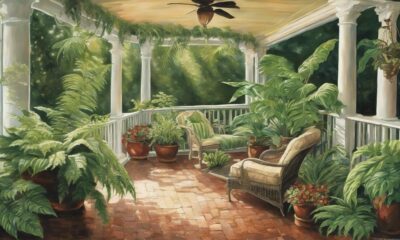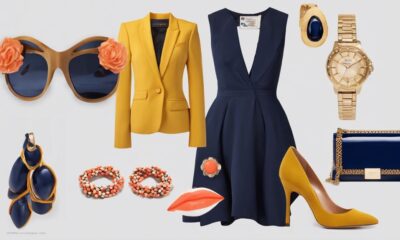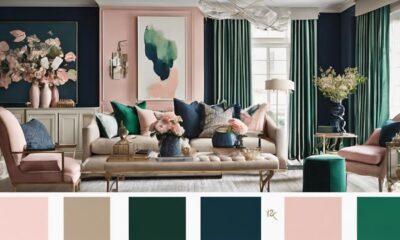Architecture Home Styles
What Is the Difference Between Modern and Mid-Century Modern Design?
Only subtle distinctions separate modern and mid-century modern design, enticing readers to uncover the nuanced differences in these popular interior styles.
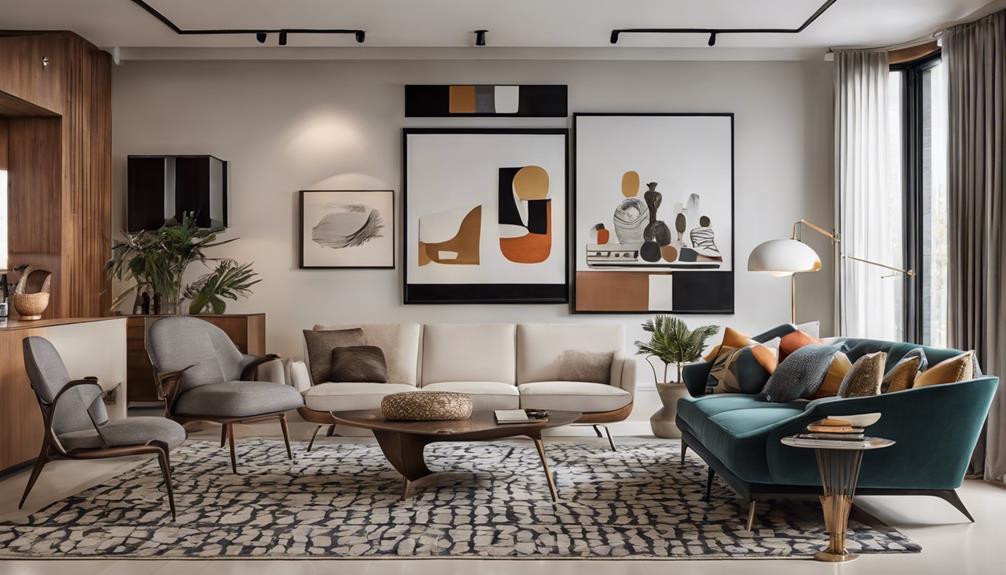
When it comes to distinguishing between modern and mid-century modern design, the differences go beyond mere aesthetics. While both styles share some similarities, such as clean lines and functionality, a closer examination reveals unique characteristics that set them apart in the world of interior design.
Understanding these nuances can help us appreciate the evolution of design trends and make informed choices when it comes to decorating our living spaces.
Key Takeaways
- Modern design emphasizes clean lines and minimalism with natural materials.
- Mid-century modern design focuses on functionality, sleekness, and bold furniture shapes.
- Modern design leans towards open spaces and large windows for light.
- Mid-century modern design incorporates warm woods, retro flair, and geometric patterns.
Origins of Modern and Mid-Century Design
Modern design emerged in the 1920s as a response to the ornate and intricate styles of traditional design. It was heavily influenced by the Bauhaus movement, which emphasized functionality and simplicity in design. The Bauhaus movement, originating in Germany, sought to combine fine arts with crafts, embracing new materials and methods of production.
Mid-century modern design evolved post-World War II, reflecting a shift towards more casual and informal living styles. This design movement integrated aspects of nature and the outdoors, blurring the lines between indoor and outdoor spaces. Mid-century modern design is characterized by flat planes, large windows, and a seamless flow between interior and exterior environments. Unlike modern design, mid-century modern design values function over form, often incorporating retro decorative accents to create a sense of nostalgia and warmth in living spaces.
Key Features of Modern Design
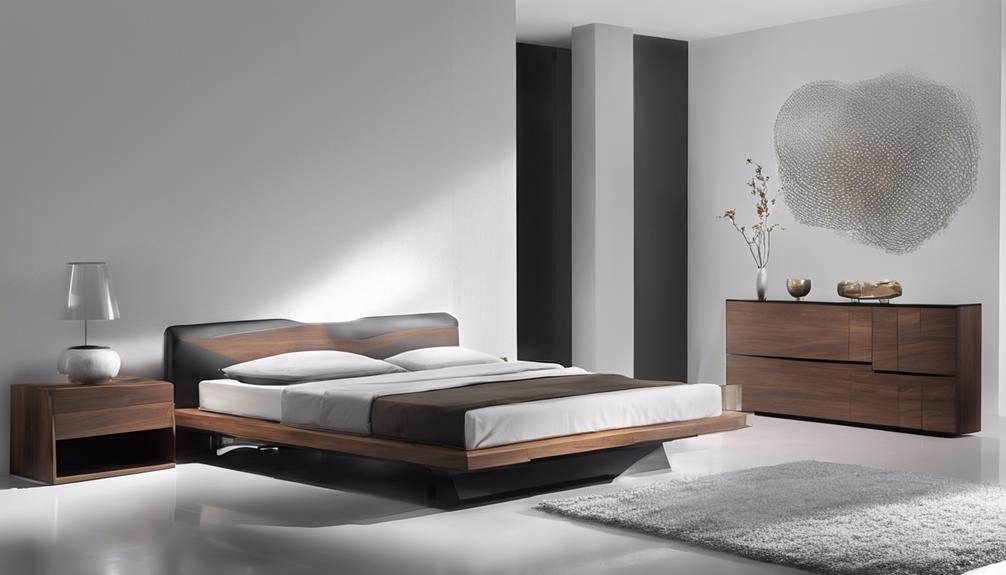
With a focus on sleek lines, minimalism, and functionality, the key features of modern design embody a timeless elegance that integrates natural materials like wood and metal.
- Clean Lines: Modern design is characterized by crisp, straight lines that create a sense of simplicity and sophistication in the space.
- Minimalism: Embracing the 'less is more' philosophy, modern design avoids clutter and excess ornamentation, focusing on essential elements that enhance the overall aesthetic.
- Natural Materials: Utilizing materials such as wood and metal, modern design brings a touch of nature indoors, adding warmth and texture to the clean and contemporary spaces.
In addition to these key features, modern design often includes open floor plans that promote a sense of airiness and fluidity throughout the area. By incorporating large windows to invite natural light and emphasizing spaciousness, modern design creates environments that are both functional and visually appealing.
Key Features of Mid-Century Modern Design
Moving from the key features of modern design, we now shift our focus to exploring the distinctive elements that define mid-century modern design. Mid-century modern design emerged post-World War II, focusing on functionality and sleekness. This style incorporates a mix of materials such as wood, metal, and glass, creating a retro yet timeless look. Clean lines, organic shapes, and pops of bold colors are key characteristics, contributing to a vibrant and unique aesthetic.
In terms of furniture, mid-century modern design often features leggy, tapered pieces made from warm-toned woods and adorned with geometric patterns. This design ethos values simplicity, functionality, and a seamless integration with nature. It's a popular choice for both residential and commercial spaces due to its timeless appeal and versatility.
When comparing Mid-Century Modern vs. modern styles, the former stands out for its attention to detail, retro charm, and enduring popularity in the world of interior design.
Incorporating Modern Design in Home Decor
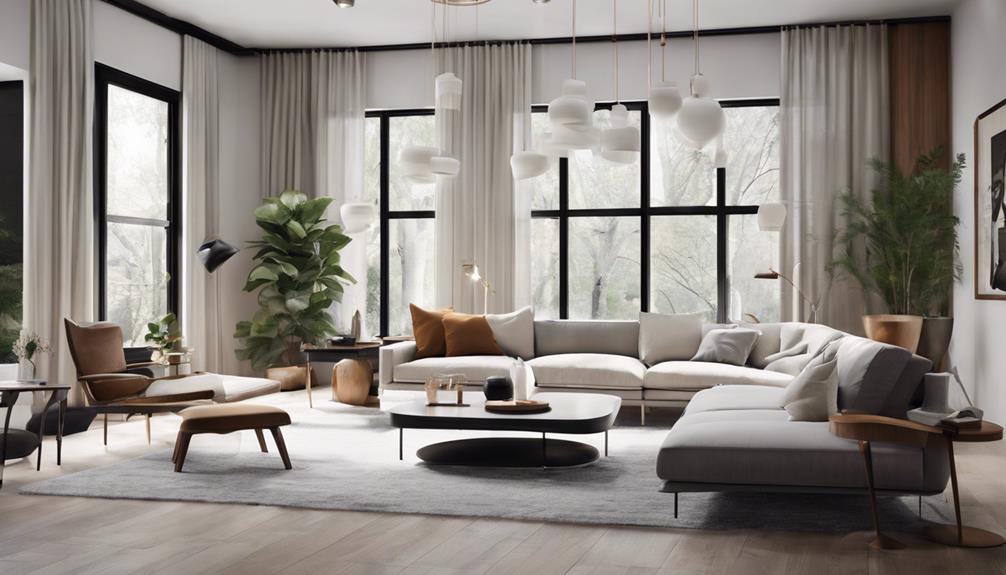
When embracing contemporary design principles in home decor, one can achieve a sense of sophistication and functionality through clean lines and natural materials. Modern designs emphasize minimalism and symmetry, creating a sleek and uncluttered space that feels open and inviting.
To incorporate modern design into your home decor effectively, consider the following:
- Choose Furniture Pieces Wisely: Opt for furniture with clean lines and simple forms to maintain the minimalist aesthetic of modern design.
- Incorporate Decorative Accents: Select decorative accents that complement the modern style, such as geometric patterns, metal finishes, or abstract artwork.
- Focus on Interior Design: Pay attention to the layout and arrangement of your space to ensure a harmonious flow and balance that reflects modern design principles.
Incorporating Mid-Century Modern Design in Home Decor
To seamlessly blend modern design principles with a touch of retro flair, consider incorporating Mid-Century Modern elements into your home decor. Originating in the mid-20th century, this design style focuses on merging indoor and outdoor living spaces, characterized by flat planes, large glass windows, and organic shapes that emphasize simplicity, functionality, and a connection to the outdoors. When it comes to furniture, mid-century modern design features elongated, bold shapes, leggy, tapered frames, and warm-toned woods that create a nostalgic retro feel.
For those looking to incorporate mid-century modern design into their home decor, decorating tips include using floor pillows, plants, low furniture, and arched lighting, while embracing abstract, atomic, and geometric patterns. Mixing mid-century modern with bohemian styles can involve combining raw or mixed wood with bold colors, eye-catching patterns, layered textures, and global accents for a unique and eclectic look that marries the past with the present in a stylish and innovative manner.
Frequently Asked Questions
How Is Mid-Century Modern Different From Modern?
We find that Mid-century modern design stands out from modern design due to its retro vibe with colorful accents and flashy decor, while modern design focuses on clean lines, minimalism, and natural materials.
Mid-century modern embraces boldness and vibrancy in decor choices, whereas modern design opts for a more understated and simplistic approach.
These distinctions allow individuals to choose between the two styles based on their preference for color schemes and overall aesthetic.
Can I Mix Modern and Mid-Century Modern?
Absolutely! Mixing modern and mid-century modern design can result in a stunning fusion of styles. By combining sleek lines and minimalism with retro elements and pops of color, you can create a unique and eclectic look in your space.
Experimenting with blending different furniture pieces, colors, and textures allows for a personalized and dynamic interior design that reflects individual style preferences. Incorporating both styles can lead to a harmonious and balanced aesthetic.
What Style Is Closest to Mid-Century Modern?
Scandinavian design closely aligns with Mid-Century Modern, emphasizing geometric shapes, tailored upholstery, and light-colored woods. This style captures the essence of simplicity and functionality, reflecting a timeless aesthetic that resonates with Mid-Century Modern principles.
How Do I Know if My Furniture Is Mcm?
When determining if furniture is mid-century modern, look for the following features:
- Clean lines and organic curves
- Materials like teak or rosewood
- Tapered legs, sleek silhouettes, and minimalist designs
- Warm earthy tones or bold hues in the color palette
- Unique decorative accents and retro patterns
- A focus on functionality
These elements can help us recognize if a piece fits the mid-century modern style.
What are the key differences between Modern and Mid-Century Modern design styles?
Modern and Mid-Century Modern design styles both prioritize simplicity and functionality, but they differ in key ways. Modern design focuses on clean lines and minimalism, while Mid-Century Modern incorporates retro elements and organic shapes. These differences make the two styles distinct in the world of modern classic vs contemporary classic design.
Conclusion
In conclusion, the differences between modern and mid-century modern design are rooted in their historical origins and distinct characteristics.
While modern design emphasizes functionality and industrial materials, mid-century modern design focuses on simplicity, nature, and a retro aesthetic.
Incorporating elements of both styles in home decor can create a unique and stylish living space that blends the best of both worlds.
Stay tuned for more tips on how to incorporate these design styles into your own home!
- About the Author
- Latest Posts
Introducing Ron, the home decor aficionado at ByRetreat, whose passion for creating beautiful and inviting spaces is at the heart of his work. With his deep knowledge of home decor and his innate sense of style, Ron brings a wealth of expertise and a keen eye for detail to the ByRetreat team.
Ron’s love for home decor goes beyond aesthetics; he understands that our surroundings play a significant role in our overall well-being and productivity. With this in mind, Ron is dedicated to transforming remote workspaces into havens of comfort, functionality, and beauty.
Architecture Home Styles
Essential Elements for Creating a Beach House Oasis
Lure your senses into a coastal dreamland with the essential elements that transform a beach house into an enchanting oasis.
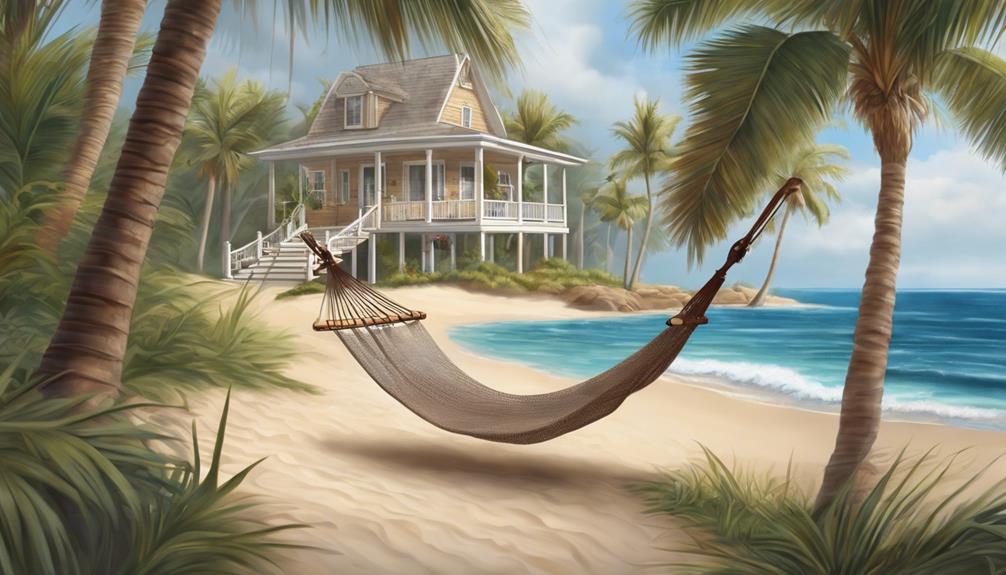
Picture this: the gentle sound of waves lapping against the shore as you relax on a sun-kissed deck, a cool breeze whispering through the palm trees.
Creating a beach house oasis requires careful consideration of elements that blend seamlessly to evoke a sense of tranquility and escape. From selecting the right materials to designing cozy nooks for lounging, each detail plays a crucial role in crafting the perfect coastal retreat.
But what truly makes a beach house oasis stand out? Let's explore together.
Key Takeaways
- Coastal color palette with natural textures for harmonious beach house vibes.
- Nautical theme incorporating marine elements for a classic seaside feel.
- Outdoor oasis elements like water features and plush seating for relaxation.
- Seaside decor with nautical accents and coastal-themed artwork for maritime charm.
Coastal Color Palette
In our quest to create a beach house oasis, we embrace a coastal color palette that harmoniously blends blues, whites, sandy tones, and natural wood finishes to infuse our space with a sense of serenity. By incorporating these coastal hues, we bring the essence of coastal living right into our home. To enhance the warmth and texture of our outdoor living area, we introduce pops of coral or turquoise as accent colors, adding visual interest and depth to the space. This blend of colors not only creates a soothing atmosphere but also reflects the beauty of the outdoors.
When designing our outdoor seating and dining areas, we ensure that the coastal decor flows seamlessly with the natural materials used. The warmth and inviting nature of the color palette make the outdoor space feel like an extension of the beach, inviting us to relax and unwind in style. By incorporating water elements, we further enhance the coastal theme, creating a tranquil ambiance that celebrates the beauty of outdoor living.
Natural Textures and Fabrics
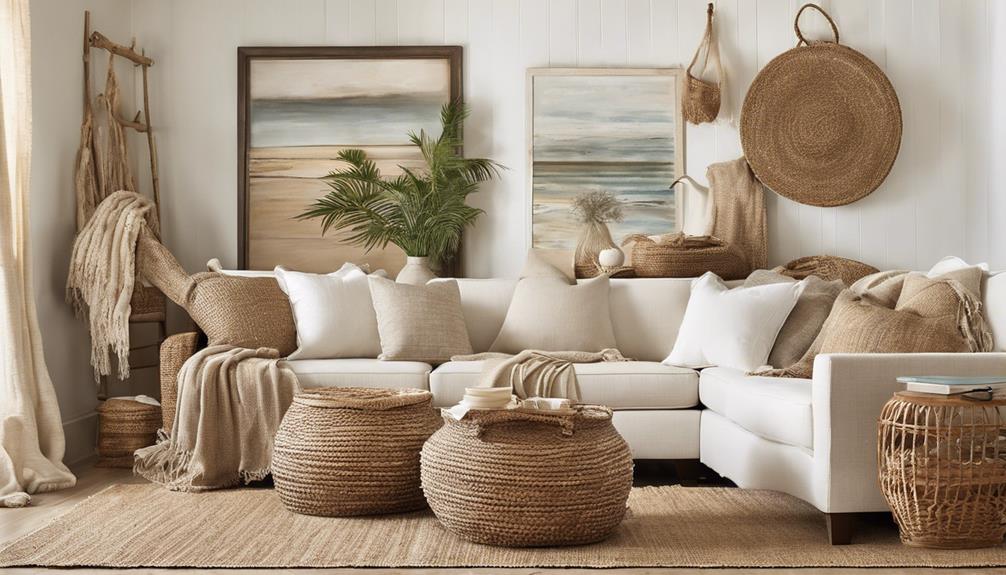
Embracing the coastal color palette sets the stage for our exploration of natural textures and fabrics. This introduces elements like jute, bamboo, and wicker to infuse our beach house oasis with a serene and beach-inspired vibe.
When it comes to creating an outdoor sanctuary, incorporating these organic materials brings a touch of the natural world into our living spaces. Opt for furniture with weathered wood finishes or driftwood accents, adding a rustic charm that complements the coastal theme effortlessly.
For a relaxed and comfortable ambiance, choose organic fabrics like cotton, linen, and hemp in sea-inspired colors and textures for rugs and throw pillows. This creates a sense of warmth and depth in every corner.
To allow the gentle coastal breeze and natural light to filter through seamlessly, select curtains or window treatments made from sheer fabrics. By incorporating these natural textures and fabrics, our beach house oasis will be a true haven of tranquility and style.
Nautical Accents
Exploring nautical accents infuses our beach house oasis with a charming coastal flair, evoking the essence of seaside living through elements like stripes, anchors, and marine-themed decor. To achieve this coastal look, we incorporate nautical decor in classic navy blue, white, and red color schemes. These colors perfectly complement the beach house's coastal theme, adding a touch of maritime elegance. Sailboat models and lighthouse decor not only enhance the ambiance but also bring character and charm to the space.
Rope accents are a fantastic way to tie in the nautical theme, adding texture and visual interest. Consider incorporating marine-themed artwork to bring the beauty of the sea indoors. These elements, combined with driftwood and ship wheels, create a cohesive beach house oasis that transports you to the shoreline. Anchor-printed throw pillows and sailcloth curtains further elevate the decor, while rope rugs add a touch of authenticity to the space. By embracing nautical accents, we transform our beach house into a maritime paradise.
Outdoor Relaxation Spaces
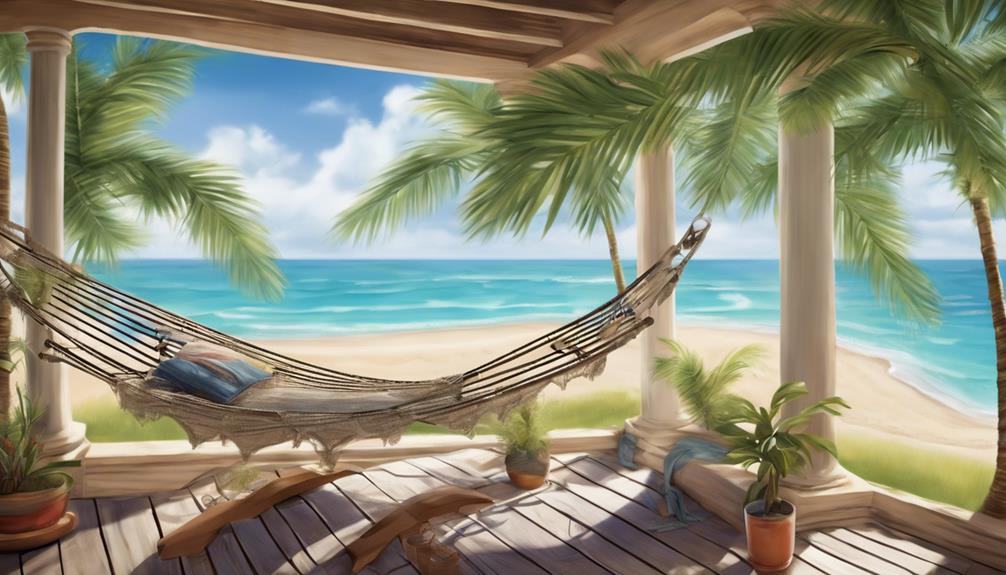
Our outdoor relaxation spaces at the beach house oasis beckon with plush seating areas and coastal-inspired comfort, perfect for unwinding under the sun.
The blend of comfortable seating like outdoor sofas and lounge chairs, adorned with fade-resistant outdoor fabrics in soothing coastal colors, creates a tranquil atmosphere.
To provide relief from the sun's rays, shade structures such as pergolas stand elegantly, offering a cool retreat while enjoying the outdoor space.
Water features like fountains or ponds add a touch of serenity to the surroundings, enhancing the overall relaxation ambiance.
For the ultimate outdoor oasis experience, consider incorporating a pool or spa into the beach house setting, elevating relaxation to new heights.
With a careful balance of comfortable seating, coastal aesthetics, shade structures, and water elements, our outdoor relaxation spaces promise a rejuvenating escape in a beachfront paradise.
Seaside-Inspired Decor
Amidst the coastal breeze, we infuse our beach house oasis with seaside-inspired decor, capturing the essence of a maritime retreat. To evoke a classic coastal vibe, we incorporate nautical elements like anchors, ropes, and ship wheels into our design scheme. The color palette of navy blue, white, and red sets the tone for a beach house aesthetic that's both timeless and refreshing.
Seashell collections, beach glass, and driftwood serve as decorative accents, bringing a touch of the seaside indoors. We adorn our space with striped patterns in textiles such as rugs, curtains, and throw pillows, adding a sense of movement and fluidity to the decor. Coastal-themed artwork featuring lighthouses, sailboats, or beach scenes adorns our walls, further enhancing the maritime ambiance.
With a keen eye for detail and a love for all things coastal, our seaside-inspired decor transforms our beach house into a sanctuary of relaxation and rejuvenation.
Frequently Asked Questions
What Are the Key Elements of Coastal Interior Design?
When considering coastal interior design, the key elements include a color palette of blues, whites, sandy tones, and natural wood finishes for a beachy vibe.
Textures play a vital role, creating depth through materials like rattan, jute, and linen.
Nautical elements, like stripes and marine-themed decor, enhance the coastal theme.
Pops of coral or turquoise in accent pieces add vibrancy.
Natural light is maximized to create a bright, breezy atmosphere reminiscent of beach living.
What Makes a Beach House Look Like a Beach House?
When we think of what makes a beach house look like a beach house, we envision pale colors, natural textures, and coastal accents.
Incorporating elements like bamboo blinds, wicker furniture, and a mix of textiles adds depth and warmth to the space.
Stripes in decor and a coastal color palette with sandy tones, blues, and greens enhance the beachy vibe. These details come together to create that unmistakable beach house ambiance we all love.
How to Design a Coastal Home?
When designing a coastal home, we blend pale colors, natural materials, and varied textures to evoke a beachy vibe. Our palette includes blues, whites, sandy tones, and vibrant coral or turquoise accents for a breezy feel.
We incorporate seaside elements like nautical decor, coral sculptures, and striped patterns for a cohesive look. Opt for functional furniture with durable fabrics and storage solutions to create a relaxed beach house ambiance.
How Do You Make Coastal Decor?
We make coastal decor by incorporating seashells, driftwood, and coral as decorative accents.
We use coastal-themed artwork like seascapes and beach scenes.
Additionally, we add textiles in beachy colors and choose accessories that reflect beach colors, textures, and themes.
These elements create a relaxing and inviting atmosphere in our beach house oasis.
Conclusion
As we wrap up our beach house oasis project, we can't help but be amazed by the power of design to transform a space into a serene retreat.
Did you know that according to a recent survey, 85% of people feel more relaxed and at peace when surrounded by coastal decor elements?
By incorporating essential elements like a coastal color palette, natural textures, nautical accents, and outdoor relaxation spaces, you can create your own beach paradise right at home.
- About the Author
- Latest Posts
Introducing Ron, the home decor aficionado at ByRetreat, whose passion for creating beautiful and inviting spaces is at the heart of his work. With his deep knowledge of home decor and his innate sense of style, Ron brings a wealth of expertise and a keen eye for detail to the ByRetreat team.
Ron’s love for home decor goes beyond aesthetics; he understands that our surroundings play a significant role in our overall well-being and productivity. With this in mind, Ron is dedicated to transforming remote workspaces into havens of comfort, functionality, and beauty.
Architecture Home Styles
How to Have a Tiny Home in Arizona: Your Essential Guide
Fascinated by the idea of a tiny home in Arizona? Discover how tax considerations can impact your journey in this essential guide.
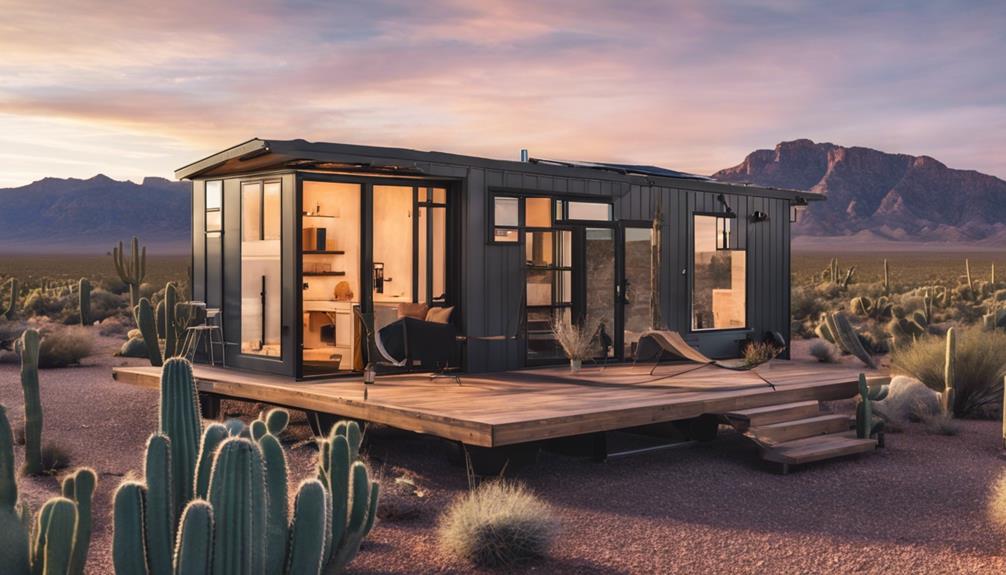
Embarking on the journey of having a tiny home in Arizona is like navigating through a desert oasis, each step revealing new insights and challenges. From understanding the intricate web of zoning laws to discovering the perfect location that aligns with your tiny living dreams, this essential guide equips you with the knowledge needed to turn your tiny home vision into reality.
But what about the unique tax considerations that come with owning a tiny home in Arizona? Stay tuned to uncover key insights that will make a difference in your tiny home journey.
Key Takeaways
- Understand Arizona zoning laws for placement in suitable zones.
- Seek permits for tiny homes based on location and structure type.
- Explore tax benefits for tiny homeowners through property tax exemptions.
- Build a supportive community through local groups and events for guidance.
Zoning Laws and Regulations in Arizona
When navigating the realm of tiny home living in Arizona, understanding the intricacies of zoning laws and regulations becomes paramount. In Arizona, zoning laws permit tiny houses on foundations in multifamily, detached single-family, and accessory dwelling unit zones.
However, for Tiny Homes on Wheels, they're typically classified as recreational vehicles and must adhere to specific parking regulations within designated zones. Maricopa County has established particular regulations for tiny houses, including constraints on the floor area allowed for permanent structures. On the other hand, Pima County imposes restrictions on Tiny Homes on Wheels through specific codes that govern their placement.
The zoning options for tiny houses in Arizona encompass various zones such as isolated single-family zones, accessory dwelling unit zones, and multifamily zones. Familiarizing oneself with these zoning laws and regulations is crucial for anyone considering embarking on the adventure of tiny home living in Arizona.
Ideal Locations for Tiny Homes
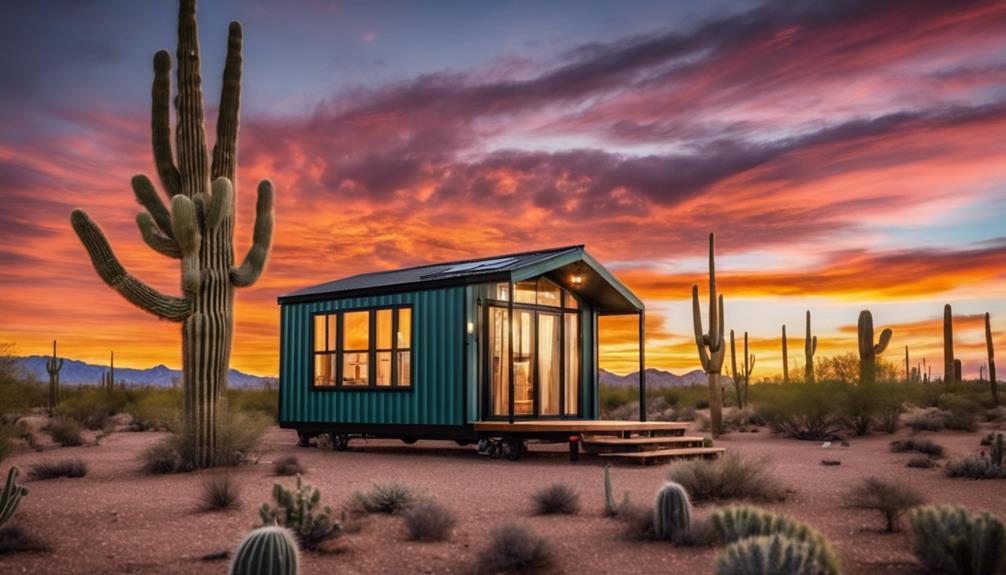
For those seeking ideal locations to establish their tiny homes in Arizona, cities like Phoenix, Tucson, Sedona, and Lakeside present attractive options. When considering where to set up your tiny home in Arizona, keep in mind that Pima County and Coconino County permit the establishment of tiny houses in specific zones. In these areas, tiny homes can be placed in isolated single-family zones, ADU zones, and multifamily zones. For those with tiny houses on wheels, it's important to note that they must be parked in designated R.V. zones in compliance with regulations.
- Phoenix, Tucson, Sedona, and Lakeside are ideal cities for setting up tiny homes in Arizona.
- Pima County and Coconino County allow tiny houses in specific zones.
- Tiny homes can be placed in single-family zones, ADU zones, and multifamily zones.
- Tiny houses on wheels must adhere to regulations in designated R.V. zones.
Tax Considerations for Tiny Home Owners
Exploring the tax implications of owning a tiny home in Arizona reveals potential benefits and considerations that can significantly impact financial planning for homeowners. Tiny home owners in Arizona may qualify for property tax exemptions based on factors like square footage and adherence to green building standards. Additionally, the size of tiny homes could lead to reduced property tax assessments in certain counties. It is crucial for Arizona tiny home owners to familiarize themselves with local tax laws to take advantage of any available tax benefits. Seeking guidance from a tax professional or local tax assessor can provide valuable insights into how owning a tiny home in Arizona may influence property taxes.
Tax Considerations for Tiny Home Owners:
| Key Points | Details | Importance |
|---|---|---|
| Property Tax Exemptions | Available based on square footage and green standards | Maximize Savings |
| Reduced Assessments | Smaller homes could mean lower tax bills | Financial Advantage |
| County Variances | Regulations differ, impacting tax benefits | Local Compliance |
| Professional Advice | Consult with tax professionals for guidance | Optimal Planning |
Finding Community Support in Arizona
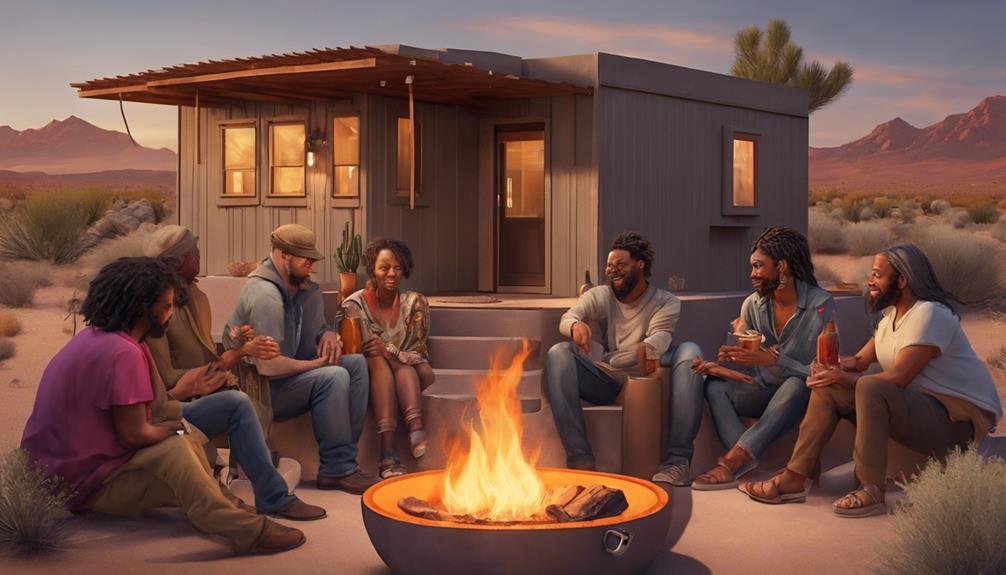
By actively engaging with local resources and networking opportunities, tiny home enthusiasts in Arizona can establish a strong sense of community support to enhance their living experience.
Here are some ways to find community support in Arizona:
- Join local Facebook groups like 'Arizona Tiny House Community' for a supportive network.
- Attend tiny house meetups and events in Arizona to connect with like-minded individuals.
- Explore tiny house workshops and seminars in the state to gain knowledge and resources.
- Consider volunteering with non-profit organizations focused on sustainable living and tiny house advocacy in Arizona.
These opportunities not only provide a sense of belonging within the tiny house community but also offer valuable insights, resources, and support for those embracing the tiny home lifestyle in Arizona.
Engaging with these avenues can enrich your experience, foster connections, and empower you to navigate the challenges and joys of sustainable living in the state.
Building and Parking Tips for Tiny Homes
Engaging with the regulations and guidelines for building and parking tiny homes in Arizona is crucial for ensuring compliance and a smooth transition into sustainable living. Tiny homes on foundations in Arizona must adhere to the 2018 IRC Appendix Q requirements, which outline specific space dimensions and safety features to guarantee structural integrity.
Building a tiny home on skids offers a semi-permanent placement option while still allowing for mobility if relocation becomes necessary. For those opting for tiny homes on wheels, meeting mobile home requirements is essential, and a minimum of 160 square feet is required for parking.
The flexibility in setting up tiny homes in various zone types in Arizona provides diverse housing options based on individual preferences. Tiny houses on wheels are particularly popular for their mobility and flexibility, making them an attractive choice for those desiring a minimalist lifestyle without sacrificing comfort.
Frequently Asked Questions
Can I Put a Tiny House on My Property in Arizona?
Yes, we can put a tiny house on our property in Arizona if it complies with local zoning regulations. Different options like multifamily, detached single-family, or accessory dwelling units are available. Land near Maricopa City, Pinal County, offers accessible placement.
How Much Does a Tiny House Cost in Az?
Tiny houses in Arizona can range from $20,000 to $200,000 depending on size and customization. DIY kits start at $8,000, but labor costs add up. Land, utilities, and permits are extra. Building a tiny house can be a cost-effective housing choice.
What Is the Minimum Square Footage for a House in Arizona?
In Arizona, the minimum square footage for a house varies based on its foundation type. For tiny houses on foundations, it's 200 square feet, while those on trailers require at least 160 square feet. Adhering to building codes is essential.
Does Arizona Have a Tiny Home Community?
We do have tiny home communities in Arizona. These communities provide shared amenities, community engagement, and a supportive environment. Living in a tiny house community offers a unique sense of belonging, shared resources, and a close-knit experience.
Conclusion
In conclusion, navigating the world of tiny homes in Arizona may seem like a daunting task, but with the right resources and community support, it can be a breeze.
From zoning laws to building tips, we've covered it all in our essential guide.
So go ahead, take the leap into tiny home living and watch your dreams of a cozy, sustainable lifestyle come to life in the Grand Canyon State!
- About the Author
- Latest Posts
Introducing Ron, the home decor aficionado at ByRetreat, whose passion for creating beautiful and inviting spaces is at the heart of his work. With his deep knowledge of home decor and his innate sense of style, Ron brings a wealth of expertise and a keen eye for detail to the ByRetreat team.
Ron’s love for home decor goes beyond aesthetics; he understands that our surroundings play a significant role in our overall well-being and productivity. With this in mind, Ron is dedicated to transforming remote workspaces into havens of comfort, functionality, and beauty.
Architecture Home Styles
Exploring the Difference Between Traditional and Classic Design
Kickstart your journey into the world of design by uncovering the subtle yet significant distinctions between traditional and classic styles, shaping your perception of timeless elegance.
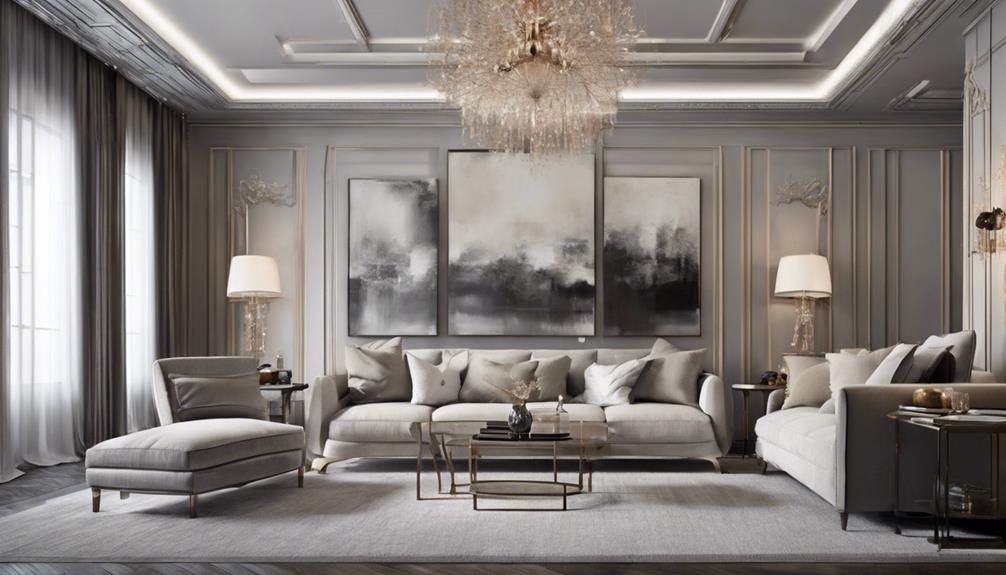
When considering traditional versus classic design, we uncover nuanced distinctions in style and aesthetic preferences. The interplay between historical influences and contemporary interpretations provides a fascinating insight into the evolution of design principles.
As we explore the intricate details and subtle nuances that set these two styles apart, it becomes evident that each offers a unique perspective on elegance and sophistication.
Stay tuned to unravel the intricacies that define the essence of traditional and classic design, shedding light on the nuances that shape our perception of timeless aesthetics.
Key Takeaways
- Traditional design features bold colors and intricate patterns, while classic design opts for soft and subdued colors for elegance.
- Both traditional and classic design styles focus on creating a balanced, inviting, and harmonious atmosphere.
- Traditional furniture embodies moderation and balance with solid wood, while classic furniture exudes nobility with gilded finishes.
- Lighting in traditional design aims for warmth and coziness, while classic design creates a luxurious ambiance with ornate fixtures.
Key Elements in Traditional Design
In traditional design, we intricately weave together elements of moderation, elegance, and balance to create a timeless aesthetic inspired by the rich European design traditions of the 18th and 19th centuries. Solid wood plays a pivotal role in this style, exuding warmth and coziness throughout the space. The choice of fabrics like cotton, leather, and velvet further enhances the comfort aspect, inviting you to sink into luxurious textures. Lighting is carefully curated to emanate a soft and inviting glow, achieved through the use of ambient sources such as table lamps and floor lamps, setting a cozy ambiance.
The color palette in traditional design is a symphony of rich colors like deep reds, lush greens, and vibrant yellows, adding depth and character to the space. These hues evoke a sense of opulence and sophistication, harmonizing beautifully with the overall design scheme. The blend of these elements creates a space that not only exudes elegance but also envelops you in a sense of comfort and luxury.
Characteristics of Classic Design
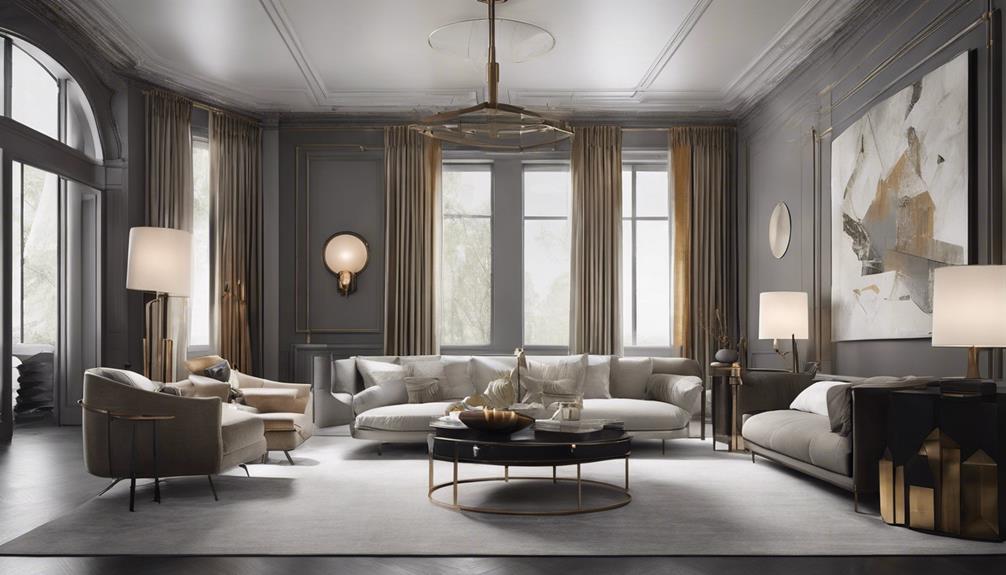
Transitioning from the rich tapestry of traditional design, classic design embodies a timeless allure through its emphasis on neutral hues, enduring furniture pieces, and ageless patterns. Classic design is about creating a space that feels elegant and sophisticated, never going out of style. This style incorporates traditional furniture pieces like wingback chairs and claw-foot tables, showcasing intricate details and a focus on symmetry. Antique or vintage items are often integrated into classic interiors to enhance the sense of heritage and history. Natural materials such as wood and marble play a significant role in classic design, adding a touch of authenticity and luxury. The use of neutral colors like beige, ivory, and taupe creates a serene and calming atmosphere, perfect for those who appreciate a refined aesthetic. Classic design is about capturing the essence of timeless beauty and creating a space that exudes grace and elegance.
| Characteristics | Description | Example |
|---|---|---|
| Neutral Colors | Create a serene atmosphere | Beige, Ivory, Taupe |
| Traditional Furniture | Emphasize heritage and sophistication | Wingback chairs, Claw-foot tables |
| Intricate Details | Showcase fine craftsmanship | Ornate carvings, Embossed patterns |
| Natural Materials | Add authenticity and luxury | Wood, Marble, Leather |
| Timeless Patterns | Enhance the sense of elegance | Damask, Toile, Houndstooth |
Color Palette Variances
Let's delve into the captivating interplay of colors in traditional and classic design, unveiling their distinct palettes and the emotions they evoke within interior spaces.
Traditional design is known for its bold use of color, incorporating rich tones like red, green, and yellow to create a lively and accented color palette. In contrast, classic design opts for a more subdued approach, favoring neutral and soft colors that convey timeless sophistication and elegance. Both styles share a common emphasis on proportion and harmony when selecting colors, ensuring a visually pleasing aesthetic within the space.
Classic design often showcases prestigious materials with subtle contrasts, exuding an air of understated luxury. On the other hand, traditional design tends to embrace vibrant colors and intricate patterns, adding a sense of energy and warmth to the room. The careful selection of color palettes in traditional and classic design plays a vital role in shaping the overall ambiance and character of the interior, showcasing a harmonious blend of elegance, proportion, and timeless sophistication.
Differences in Furniture Styles
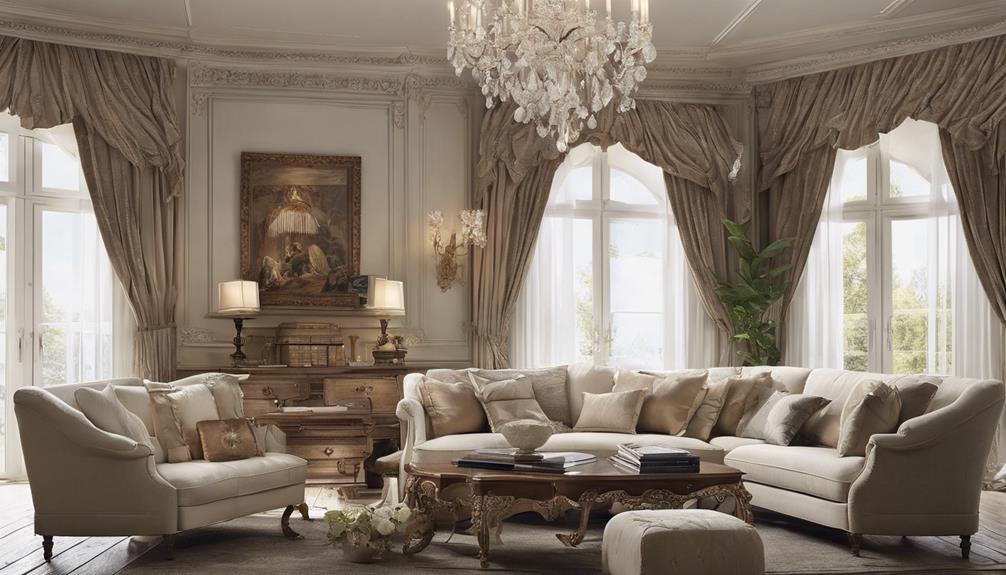
Embarking on a journey through the realm of interior design, we are met with a striking divergence in furniture styles between traditional and classic design aesthetics. Traditional furniture in European design, originating from the 18th and 19th centuries, embodies moderation, elegance, and balance. On the other hand, classic furniture exudes noble atmospheres with pomposity, showcasing prestigious materials like oak, mahogany, ceramic, marble, gold, and silver finishes.
| Traditional Furniture | Classic Furniture |
|---|---|
| Rooted in European design | Exudes ethereal nobility |
| Favoring moderation | Prestigious materials |
| Warmth and coziness | Gilded and opulent |
In traditional style, harmony is achieved through blending various elements, offering warmth and coziness with solid wood furniture and fabrics like cotton, leather, and velvet. In contrast, classic style features gilded finishes and gold leaf for a luxurious look, emphasizing richness and opulence. These styles also extend into lighting design, with traditional opting for warmer and softer lighting, creating a cozy feel with ambient lighting solutions like table lamps and floor lamps, while classic style leans towards ornate chandeliers and sconces for a grandiose touch.
Lighting Design Variances
As we delve into the realm of lighting design variances, a captivating interplay emerges between classic and traditional interior styles, each illuminating spaces with unique charm and character. Classic design exudes richness and opulence through lighting fixtures like grand chandeliers and intricately detailed sconces. These ornate details in classic lighting fixtures create a luxurious ambiance, evoking a sense of grandeur and sophistication within a space.
On the other hand, traditional design takes a softer approach, opting for warmer and cozier lighting solutions such as table lamps and floor lamps. The emphasis in traditional design is on creating a welcoming and comfortable environment, where ambient lighting plays a pivotal role in setting the mood. This style aims to promote a sense of intimacy and relaxation, steering away from the grandiose nature of classic design.
Both classic and traditional design styles strive for elegant lighting options that not only serve a functional purpose but also enhance the overall ambiance of a room. Whether it's the opulence of classic chandeliers or the cozy feel of traditional table lamps, lighting design plays a crucial role in shaping the character of a space.
Frequently Asked Questions
How Is Traditional Design Different From Modern Design?
Traditional design differs from modern design in various aspects.
We see traditional design focusing on warmth and rich colors like red and green, while modern design emphasizes sleek lines and minimalism.
Traditional design incorporates natural materials like wood for a cozy atmosphere, whereas modern design utilizes innovative materials for a contemporary look.
The former favors classic furniture with intricate details, while the latter features unique furniture and cutting-edge designs.
What Is the Definition of Traditional Design?
When it comes to traditional design, it's like stepping into a cozy retreat filled with elegant charm. Rich colors like red, green, and yellow dance together, creating a lively palette.
Classic lines and solid wood furniture greet you warmly, while fabrics like cotton and velvet whisper comfort and luxury. It's a timeless style that wraps you in a familiar embrace, making every corner of your home feel like a cherished memory.
What Is the Difference Between Modern Design and Classic Design?
When it comes to modern design and classic design, the distinction lies in their contrasting aesthetics.
Modern design embodies sleek lines and cutting-edge materials, reflecting a contemporary and innovative vibe.
In contrast, classic design exudes elegance and timeless sophistication with its traditional furniture and luxurious details.
These two styles offer a unique blend of old-world charm and futuristic elements, catering to different tastes and preferences in the world of design.
What Is the Difference Between Modern and Classic Home Design?
When it comes to modern and classic home design, the distinction lies in their essence.
Modern design embodies innovation and creativity with sleek lines and cutting-edge materials, ideal for those seeking a contemporary aesthetic.
Classic design, on the other hand, exudes elegance and sophistication through timeless pieces and intricate details, appealing to those who value tradition and refinement in their living spaces.
These contrasting styles offer unique choices for expressing personal taste and style preferences.
How Does Traditional Design Differ from Classic Design in Terms of Aesthetics and Functionality?
Traditional design encompasses a more ornate and intricate aesthetic, while classic design focuses on simplicity and elegance. In terms of functionality, traditional design often prioritizes practicality, while classic design may incorporate more decorative elements. The main difference between modern design and traditional design lies in their approach to aesthetics and practicality.
Conclusion
As we wrap up our exploration of traditional and classic design, it's clear that these styles offer unique and distinct characteristics. From the cozy warmth of traditional design to the timeless elegance of classic design, each style brings its own charm and sophistication to any space.
Whether you prefer the rich colors and intricate details of traditional design or the opulent finishes and neutral palettes of classic design, there's no doubt that both styles can create a truly stunning and inviting atmosphere.
So, which style speaks to you?
- About the Author
- Latest Posts
Introducing Ron, the home decor aficionado at ByRetreat, whose passion for creating beautiful and inviting spaces is at the heart of his work. With his deep knowledge of home decor and his innate sense of style, Ron brings a wealth of expertise and a keen eye for detail to the ByRetreat team.
Ron’s love for home decor goes beyond aesthetics; he understands that our surroundings play a significant role in our overall well-being and productivity. With this in mind, Ron is dedicated to transforming remote workspaces into havens of comfort, functionality, and beauty.
-

 Vetted2 days ago
Vetted2 days ago15 Best Boxwood Varieties for Thriving in Full Sunlight
-

 Vetted5 days ago
Vetted5 days ago15 Best Ways to Label Clothes for Nursing Home Residents – Stay Organized and Efficient
-

 Vetted3 days ago
Vetted3 days ago15 Best Dryer Vent Hoses to Keep Your Laundry Room Safe and Efficient
-

 Vetted3 days ago
Vetted3 days ago15 Best Spider Sprays to Keep Your Home Arachnid-Free
-

 Vetted2 days ago
Vetted2 days ago14 Best Cleaners for Aluminum Surfaces – Shine Bright Like a Diamond
-

 Vetted3 days ago
Vetted3 days ago15 Best Nightstand Charging Stations to Keep Your Devices Organized and Ready to Go
-

 Beginners Guides15 hours ago
Beginners Guides15 hours agoHow to Slow Down My Ceiling Fan to Reduce Wind Chill
-

 Vetted5 days ago
Vetted5 days ago15 Best Beer Fridges to Keep Your Brews Cold and Ready to Enjoy





